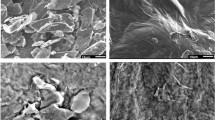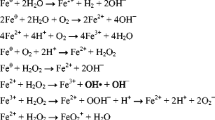Abstract
Owing to the novel physicochemical properties of graphene, materials such as graphene oxide (GO) are being developed for applications in various fields such as biomedicine. Nonetheless, considerable knowledge gaps still exist regarding the impact of GOs on environmental health and safety (EHS). Thus far, its secondary toxicity, synergistic effects, and mal-adaption have not been focused much upon. Here, we show that at low concentrations (that did not directly result in significant cytotoxicity), GO could greatly enhance metal toxicity in macrophages by altering their cellular priming state. Specifically, GO caused impairments to the cellular morphology and membrane integrity of macrophages, and remarkably enhanced the cellular uptake of Cd and other non-essential metal ions (such as Hg and Gd). Furthermore, upon low-dose GO pre-treatment, the uptake of Cd at a non-toxic concentration brought about a remarkable amount of oxidative stress in macrophages, and ultimately resulted in increased cell death. Mechanistic investigations illustrated that GO pre-treatment triggered cell death through apoptosis because of Cd exposure. Overall, this study’s results reveal a new path for understanding the impact of GOs on EHS through the perspective of its synergistic and secondary effects, previously unidentified mechanisms via which nanomaterials might pose detrimental effects on organisms.

Similar content being viewed by others
References
Jahan, S.; Yusoff, I. B.; Alias, Y. B.; Bakar, A. F. B. A. Reviews of the toxicity behavior of five potential engineered nanomaterials (ENMs) into the aquatic ecosystem. Toxicol. Rep. 2017, 4, 211–220.
Xia, T.; Zhu, Y.; Mu, L.; Zhang, Z. F.; Liu, S. Pulmonary diseases induced by ambient ultrafine and engineered nanoparticles in twenty-first century. Natl. Sci. Rev. 2016, 3, 416–429.
Wu, T. S.; Tang, M. Review of the effects of manufactured nanoparticles on mammalian target organs. J. Appl. Toxicol. 2018, 38, 25–40.
Libralato, G.; Galdiero, E.; Falanga, A.; Carotenuto, R.; de Alteriis, E.; Guida, M. Toxicity effects of functionalized quantum dots, gold and polystyrene nanoparticles on target aquatic biological models: A review. Molecules 2017, 22, 1439.
Bostan, H. B.; Rezaee, R.; Valokala, M. G.; Tsarouhas, K.; Golokhvast, K.; Tsatsakis, A. M.; Karimi, G. Cardiotoxicity of nano-particles. Life Sci. 2016, 165, 91–99.
Higashisaka, K.; Nagano, K.; Yoshioka, Y.; Tsutsumi, Y. Nano-safety research: Examining the associations among the biological effects of nanoparticles and their physicochemical properties and kinetics. Biol. Pharm. Bull. 2017, 40, 243–248.
Krug, H. F. Nanosafety research—Are we on the right track? Angew. Chem., Int. Ed. 2014, 53, 12304–12319.
Valsami-Jones, E.; Lynch, I. How safe are nanomaterials? Science 2015, 350, 388–389.
Orecchioni, M.; Bedognetti, D.; Newman, L.; Fuoco, C.; Spada, F.; Hendrickx, W.; Marincola, F. M.; Sgarrella, F.; Rodrigues, A. F.; Ménard-Moyon, C. et al. Single-cell mass cytometry and transcriptome profiling reveal the impact of graphene on human immune cells. Nat. Commun. 2017, 8, 1109.
Ema, M.; Gamo, M.; Honda, K. A review of toxicity studies on graphene-based nanomaterials in laboratory animals. Regul. Toxicol. Pharm. 2017, 85, 7–24.
Ma, J.; Li, R. B.; Liu, Y.; Qu, G. B.; Liu, J.; Guo, W. L.; Song, H. Y.; Li, X. H.; Liu, Y. J.; Xia, T. et al. Carbon nanotubes disrupt iron homeostasis and induce anemia of inflammation through inflammatory pathway as a secondary effect distant to their portal-of-entry. Small 2017, 13, 1603830.
Ma, J.; Li, R. B.; Qu, G. B.; Liu, H. Y.; Yan, B.; Xia, T.; Liu, Y. J.; Liu, S. J. Carbon nanotubes stimulate synovial inflammation by inducing systemic pro-inflammatory cytokines. Nanoscale 2016, 8, 18070–18086.
Chen, Y. J.; Wu, Y. K.; Sun, B. B.; Liu, S. J.; Liu, H. Y. Two-dimensional nanomaterials for cancer nanotheranostics. Small 2017, 13, 1603446.
Wang, K.; Ruan, J.; Song, H.; Zhang, J. L.; Wo, Y.; Guo, S. W.; Cui, D. X. Biocompatibility of graphene oxide. Nanoscale Res. Lett. 2011, 6, 8.
Khan, A.; Wang, J.; Li, J.; Wang, X. X.; Chen, Z. S.; Alsaedi, A.; Hayat, T.; Chen, Y. T.; Wang, X. K. The role of graphene oxide and graphene oxide-based nanomaterials in the removal of pharmaceuticals from aqueous media: A review. Environ. Sci. Pollut. Res. Int. 2017, 24, 7938–7958.
Zhao, H.; Ding, R. H.; Zhao, X.; Li, Y. W.; Qu, L. L.; Pei, H.; Yildirimer, L.; Wu, Z. W.; Zhang, W. X. Graphene-based nanomaterials for drug and/or gene delivery, bioimaging, and tissue engineering. Drug Discov. Today 2017, 22, 1302–1317.
Ema, M.; Gamo, M.; Honda, K. A review of toxicity studies on graphene-based nanomaterials in laboratory animals. Regul. Toxicol. Pharmacol. 2017, 85, 7–24.
Zhao, J.; Wang, Z. Y.; White, J. C.; Xing, B. S. Graphene in the aquatic environment: Adsorption, dispersion, toxicity and transformation. Environ. Sci. Technol. 2014, 48, 9995–10009.
Cerrillo, C.; Barandika, G.; Igartua, A.; Areitioaurtena, O.; Mendoza, G. Key challenges for nanotechnology: Standardization of ecotoxicity testing. J. Environ. Sci. Health C 2017, 35, 104–126.
Bengtson, S.; Knudsen, K. B.; Kyjovska, Z. O.; Berthing, T.; Skaug, V.; Levin, M.; Koponen, I. K.; Shivayogimath, A.; Booth, T. J.; Alonso, B. et al. Differences in inflammation and acute phase response but similar genotoxicity in mice following pulmonary exposure to graphene oxide and reduced graphene oxide. PLoS One 2017, 12, e0178355.
Zhang, X. L.; Zhou, Q. X.; Zou, W.; Hu, X. G. Molecular mechanisms of developmental toxicity induced by graphene oxide at predicted environmental concentrations. Environ. Sci. Technol. 2017, 51, 7861–7871.
Mittal, S.; Kumar, V.; Dhiman, N.; Chauhan, L. K. S.; Pasricha, R.; Pandey, A. K. Physico-chemical properties based differential toxicity of graphene oxide/reduced graphene oxide in human lung cells mediated through oxidative stress. Sci. Rep. 2017, 7, 39548.
Lu, C. J.; Jiang, X. F.; Junaid, M.; Ma, Y. B.; Jia, P. P.; Wang, H. B.; Pei, D. S. Graphene oxide nanosheets induce DNA damage and activate the base excision repair (BER) signaling pathway both in vitro and in vivo. Chemosphere 2017, 184, 795–805.
Radunovic, M.; De Colli, M.; De Marco, P.; Di Nisio, C.; Fontana, A.; Piattelli, A.; Cataldi, A.; Zara, S. Graphene oxide enrichment of collagen membranes improves DPSCs differentiation and controls inflammation occurrence. J. Biomed. Mater. Res. A 2017, 105, 2312–2320.
Tabish, T. A.; Pranjol, M. Z. I.; Hayat, H.; Rahat, A. A. M.; Abdullah, T. M.; Whatmore, J. L.; Zhang, S. W. In vitro toxic effects of reduced graphene oxide nanosheets on lung cancer cells. Nanotechnology 2017, 28, 504001.
Sanchez, V. C.; Jachak, A.; Hurt, R. H.; Kane, A. B. Biological interactions of graphene-family nanomaterials: An interdisciplinary review. Chem. Res. Toxicol. 2012, 25, 15–34.
Ou, L. L.; Song, B.; Liang, H. M.; Liu, J.; Feng, X. L.; Deng, B.; Sun, T.; Shao, L. Q. Toxicity of graphene-family nanoparticles: A general review of the origins and mechanisms. Part. Fibre Toxicol. 2016, 13, 57.
Zhao, J.; Wang, Z. Y.; White, J. C.; Xing, B. S. Graphene in the aquatic environment: Adsorption, dispersion, toxicity and transformation. Environ. Sci. Technol. 2014, 48, 9995–10009.
Järup, L. Hazards of heavy metal contamination. Br. Med. Bull. 2003, 68, 167–182.
Nawrot, T. S.; Staessen, J. A.; Roels, H. A.; Munters, E.; Cuypers, A.; Richart, T.; Ruttens, A.; Smeets, K.; Clijsters, H.; Vangronsveld, J. Cadmium exposure in the population: From health risks to strategies of prevention. Biometals 2010, 23, 769–782.
Kovtyukhova, N. I.; Ollivier, P. J.; Martin, B. R.; Mallouk, T. E.; Chizhik, S. A.; Buzaneva, E. V.; Gorchinskiy, A. D. Layer-by-layer assembly of ultrathin composite films from micron-sized graphite oxide sheets and polycations. Chem. Mater. 1999, 11, 771–778.
Zhu, J. Q.; Xu, M.; Gao, M.; Zhang, Z. H.; Xu, Y.; Xia, T.; Liu, S. J. Graphene oxide induced perturbation to plasma membrane and cytoskeletal meshwork sensitize cancer cells to chemotherapeutic agents. ACS Nano 2017, 11, 2637–2651.
Xu, M.; Zhu, J. Q.; Wang, F. F.; Xiong, Y. J.; Wu, Y. K.; Wang, Q. Q.; Weng, J.; Zhang, Z. H.; Chen, W.; Liu, S. J. Improved in vitro and in vivo biocompatibility of graphene oxide through surface modification: Poly(acrylic acid)-functionalization is superior to PEGylation. ACS Nano 2016, 10, 3267–3281.
Wang, A. X.; Pu, K. F.; Dong, B.; Liu, Y.; Zhang, L. M.; Zhang, Z. J.; Duan, W.; Zhu, Y. M. Role of surface charge and oxidative stress in cytotoxicity and genotoxicity of graphene oxide towards human lung fibroblast cells. J. Appl. Toxicol. 2013, 33, 1156–1164.
Luo, N.; Weber, J. K.; Wang, S.; Luan, B. Q.; Yue, H.; Xi, X. B.; Du, J.; Yang, Z. X.; Wei, W.; Zhou, R. H. et al. PEGylated graphene oxide elicits strong immunological responses despite surface passivation. Nat. Commun. 2017, 8, 14537.
Bardhan, N. M.; Kumar, P. V.; Li, Z. Y.; Ploegh, H. L.; Grossman, J. C.; Belcher, A. M.; Chen, G. Y. Enhanced cell capture on functionalized graphene oxide nanosheets through oxygen clustering. ACS Nano 2017, 11, 1548–1558.
Wu, C. H.; He, Q. M.; Zhu, A. N.; Yang, H.; Liu, Y. Y. Probing the protein conformation and adsorption behaviors in nanographene oxide-protein complexes. J. Nanosci. Nanotechnol. 2014, 14, 2591–2598.
Ma, J.; Liu, R.; Wang, X.; Liu, Q.; Chen, Y. N.; Valle, R. P.; Zuo, Y. Y.; Xia, T.; Liu, S. J. Crucial role of lateral size for graphene oxide in activating macrophages and stimulating pro-inflammatory responses in cells and animals. ACS Nano 2015, 9, 10498–10515.
Hong, S.; Bielinska, A. U.; Mecke, A.; Keszler, B.; Beals, J. L.; Shi, X. Y.; Balogh, L.; Orr, B. G.; Baker, J. R., Jr.; Banaszak Holl, M. M. Interaction of poly(amidoamine) dendrimers with supported lipid bilayers and cells: Hole formation and the relation to transport. Bioconjugate Chem. 2004, 15, 774–782.
Freisinger, E.; Vašák, M. Cadmium in metallothioneins. Met. Ions Life Sci. 2013, 11, 339–371.
Xu, M.; Yang, L. M.; Wang, Q. Q. Chemical interactions of mercury species and some transition and noble metals towards metallothionein (Zn7MT-2) evaluated using SEC/ICP-MS, RP-HPLC/ESI-MS and MALDI-TOF-MS. Metallomics 2013, 5, 855–860.
Marrocco, I.; Altieri, F.; Peluso, I. Measurement and clinical significance of biomarkers of oxidative stress in humans. Oxid. Med. Cell. Longev. 2017, 2017, Article ID 6501046.
Monti, D. M.; De Simone, G.; Langella, E.; Supuran, C. T.; Di Fiore, A.; Monti, S. M. Insights into the role of reactive sulfhydryl groups of carbonic anhydrase III and VII during oxidative damage. J. Enzyme Inhib. Med. Chem. 2017, 32, 5–12.
Tummers, B.; Green, D. R. Caspase-8: Regulating life and death. Immunol. Rev. 2017, 277, 76–89.
Acknowledgements
This work was supported by the National Basic Research Program of China (No. 2014CB932000), the Strategic Priority Research Program of the Chinese Academy of Sciences (No. XDB14000000), the National Natural Science Foundation of China (Nos. 21425731, 21425729, 21637004, 21407169, 21077128 and 21577097), the Science & Technology Development Fund of Tianjin Education Commission for Higher Education (No. 2017KJ209) and China Postdoctoral Science Foundation funded project (No. H037).
Author information
Authors and Affiliations
Corresponding authors
Electronic supplementary material
12274_2018_1996_MOESM1_ESM.pdf
Low-dose exposure to graphene oxide significantly increases the metal toxicity to macrophages by altering their cellular priming state
Rights and permissions
About this article
Cite this article
Zhu, J., Xu, M., Wang, F. et al. Low-dose exposure to graphene oxide significantly increases the metal toxicity to macrophages by altering their cellular priming state. Nano Res. 11, 4111–4122 (2018). https://doi.org/10.1007/s12274-018-1996-x
Received:
Revised:
Accepted:
Published:
Issue Date:
DOI: https://doi.org/10.1007/s12274-018-1996-x




